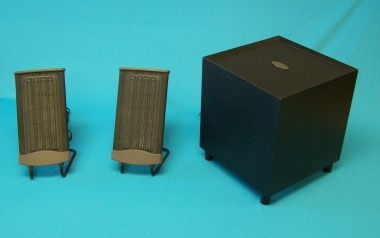I'm listening to AMTs - and they're great. The patent, taken out in the 70s, has expired, I believe.
Here's a review I posted on another forum, of the Mark & Daniel Sapphire. The kit I used was simply that on my system pages.
"I’ll start this mini-review by providing a link to a review:
http://www.positive-feedback.com/Issue38/mark_daniel.htm
That’s a pretty good review, I think. Not far off the mark (& Daniel).
Anyway, I first heard these driven by Chapter Audio amps at Bristol 2008 and was gobsmacked. Where’s the sub for these? Looked around – there wasn’t one, yet these little things were pumping out bass like there was no tomorrow. The woofer excursions where insane, and when you put your hand round the back of the speakers to monitor the airflow, the pumping you get is unbelievable.
Think Wilson for the cabinets. They are very inert indeed, and contribute substantially to holding that small dynamic drive unit steady, whilst keeping colouration from the box to low levels. It might be Corian, but I’m not 100% sure on that.
I tried them in the lounge with a Behringer A500, bi-wired with bellwire (seriously!) and a PC with a cheap on-board soundcard, mainly using Napster as a source. Results were OK, but not what I remembered. And nor should it be with that low bit rate source.
So I took them into the listening room last night for a good session. Driving components were as per what you can see to the left, plus a Trichord Delphini/Never Connected PSU. Speaker cable in use was Nordost Red Dawn Rev II bi-wire cables, with an Air Tight passive pre + $1000 upgraded pot.
The results were so much better than the earlier attempt with the Behringer. These speakers just love tubes, the Air Motion drivers in particular. Loads of space/air what have you. My wife said they sounded very detailed but in a way that is not at all harsh.
What really was impressive was the sheer speed of the bass. The 211s seem to control these speakers better than the Behringer, oddly sounding as though they had much more control over the speakers than the solid state alternative (200 odd Watts into 4 Ohms). But this control was free and easy, if that makes any sense, and I was presented with a huge soundstage for the size of the boxes.
I’d say the bass output was too high, really, in this environment. I felt the bass cones on my Martin Logans – 3 Descent and 2 Ascent woofers all moving along in harmony with the Sapphire’s! There’s also a guitar amp with a 12 inch driver in there too, so it’s not surprising. No way I’m hiking all that kit out, I thought.
I think they need to be gotten off the ground quite a bit. The M&D stands should do that when they turn up. They also need to be in free space away from corners/walls to stop any re-enforcement of the lower frequencies causing too much apparent output.
Overall, though, they are just really good for the £600 I paid for them ($2350 new) and £80 for the $700 stands.
The Air Motion tweeter/mid unit goes from 900Hz to 25KHz, and the blending with the woofer is fairly harmonious, but, as ever with most speakers employing dissimilar drive unit technologies, you do know it’s there. But it’s not as bad as most examples it this price range. In fact, it's pretty good. I must say the resolving power of the Air Motion unit is up there with an electrostatic panel. It retrieves copious amounts of very fine detail, and somehow does it without ever sounding harsh.
Required: a better PC soundcard, and some decent bi-wire cable. I’ve been suspicious of the on-board chipset, which simply sounds distorted with piano or some high bass notes, for some reason. If I do that, and use CDs as a source, I’m positive the Behringer combo will fare much better. I’ll probably report back on that.
Soundcard will probably be an Asus Xonar Essence ST."
All I can say is well done Martin Logan for realising AMTs are really good.










